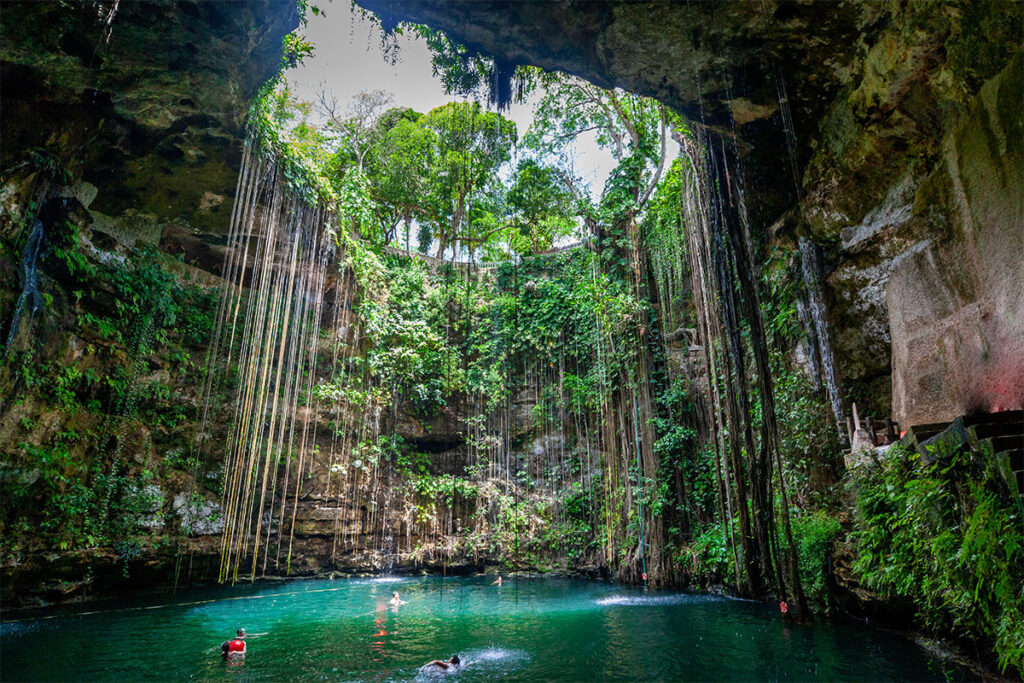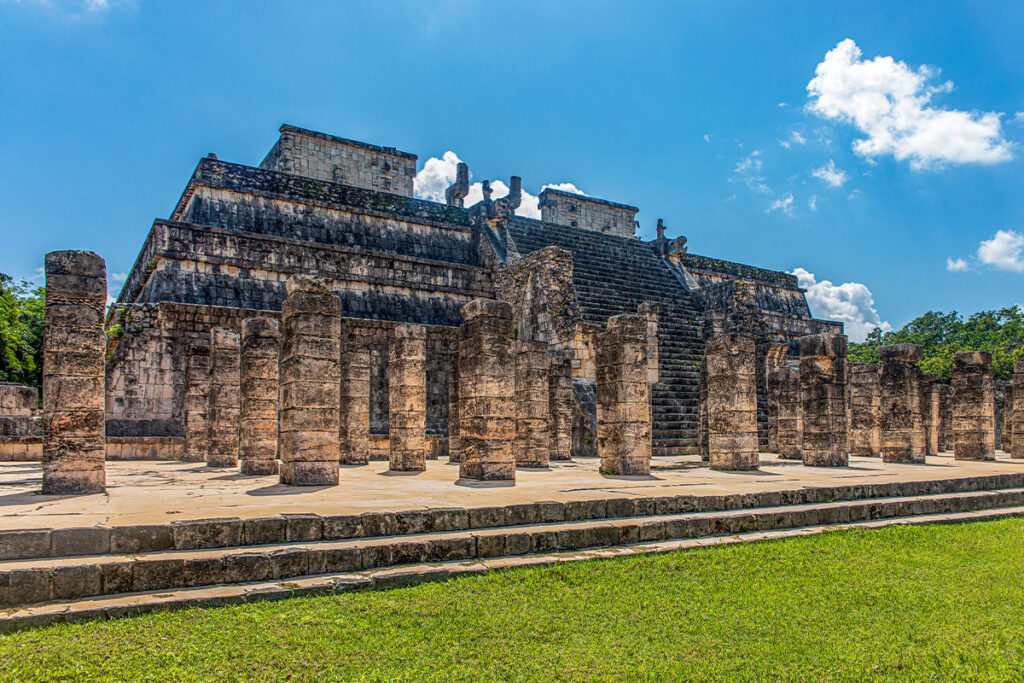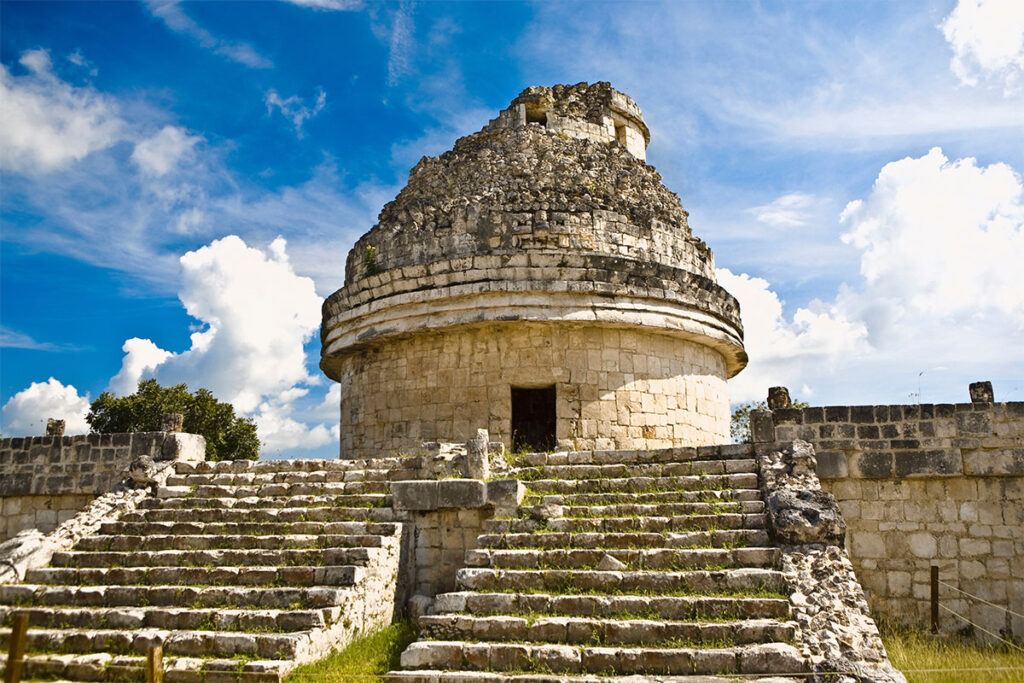Chichen Itza, the iconic Maya ruins shrouded in mystique, beckons history enthusiasts and curious travelers alike. Why is this ancient city so revered?
Our guide peels back the layers of time to reveal the awe-inspiring architecture, the sophisticated celestial observatories, and the deep spiritual practices reflected in the sacred cenotes. Moreover, we provide essential tips for experiencing Chichen Itza’s grandeur firsthand, making your visit both enlightening and unforgettable.
Key Takeaways
- Chichen Itza is a UNESCO World Heritage Site and a historical marvel of the Mayan civilization, showcasing their cultural heritage, spirituality, and advanced understanding of astronomy and architecture.
- Key highlights of the site include the Temple of Kukulcan, which symbolizes the Mayan calendar with its 365 steps, and the Great Ball Court, reflecting the Mayans’ blend of sports, religion, and symbolism.
- Visitors are encouraged to explore nearby attractions such as Cenote Yokdzonot and Cenote Ik Kil, and it’s recommended to visit early or late to avoid crowds, with comfortable footwear and adherence to health guidelines.
Standing as a silent testament to the brilliance of the Mayan civilization, Chichen Itza casts a mystic spell on every visitor. This ancient city, tucked away in the Yucatan Peninsula, is a UNESCO World Heritage site that echoes the tales of a glorious past. Founded by the Itza, an ethnic group of Mayans, in the 5th century AD, Chichen Itza was much more than a city. It was a sacred site, a center of pilgrimage, and a symbol of Mayan cultural heritage.
Its name, meaning ‘At the mouth of the well of the Itza,’ is as intriguing as its history. The Mayans named it so because of its proximity to two large natural sinkholes, which were considered sacred. These cenotes were not just geographical features but a significant part of the Mayan culture and spirituality.
In contemporary Central Mexico, Chichen Itza holds a place of reverence as a pre hispanic city. It was not just a place of worship but also a cultural capital and a crucial commercial center. Chichen Itza built by the Itza Maya, a fascinating ethnic group native to the Péten region of northern Guatemala and parts of Belize, this city has left a lasting imprint on Mexico’s cultural landscape.
The Mexican government has worked tirelessly to uphold the grandeur of Chichen Itza. They’ve engaged in extensive efforts to rehabilitate and protect its structures. Every action, whether it’s investigation, conservation, interpretation, or administration, is designed to perpetuate Chichen Itza’s legacy, inspiring generations to come.
The Founding of Chichen Itza
The story of how Chichen Itza began carries a captivating tale, as mesmerizing as the city itself. The Itza Maya, an incredible Maya ethnic group from the Péten region of northern Guatemala and parts of Belize, were the masterminds behind this city. They chose Mexico’s Yucatan Peninsula, a location blessed with natural beauty and resources, to establish their sacred city in the 5th century AD.
Chichen Itza quickly evolved into a pilgrimage hub for the Mayans, and rightfully so. Its sacred cenotes were considered as portals to the underworld, and the city itself was a beacon of spirituality. The presence of the Sacred Cenote, a site for sacrifices during droughts, further accentuated its religious significance. This reverence is why Chichen Itza is a UNESCO World Heritage Site today.
But the city was not just a spiritual hub. Chichen Itza was a significant regional capital, a center of trade, and a large city. It commanded respect from surrounding areas and showcased the rich cultural heritage of the Maya people. Even today, the city stands as a testament to the grandeur of Mayan civilization.
Architectural Wonders

A leisurely walk through the city is all it takes for the architectural brilliance of Chichen Itza to leave you in awe. The Maya’s mastery over architecture is evident in every corner of the city. Among the numerous structures that adorn the cityscape, El Castillo stands out for its sheer magnificence. Also known as the Pyramid of Kukulcan, it is a remarkable structure with four stairways, each with 91 steps leading up to a platform at the top. The total 365 steps symbolize the days of a year, demonstrating the Mayans’ profound understanding of astronomy. The pyramid’s nine levels and square temples on each side beautifully encapsulate the Maya cosmology and craftsmanship.
The Temple of Warriors is yet another testament to the architectural prowess of the Mayans. Constructed by the Maya, this temple showcases the Puuc-style architecture, distinguished by intricate stone mosaics and detailed carvings. Each carving is a window into the cultural richness of the Mayan civilization. And the best part? These Mayan ruins, Chichen Itza, are accessible from popular tourist destinations like Playa del Carmen, making it a must-visit site for travelers.
But the city is not just about grand structures. Chichen Itza’s architecture beautifully reflects the rich culture and spirituality of the Maya. The alignment of buildings for astrological events, the representation of religious rituals, and the Maya cosmovision within its structural designs are truly remarkable. It’s a testament to the history of the Northern Maya Lowlands.
Exploring El Castillo: The Pyramid of Kukulkan
A tour around El Castillo, the Pyramid of Kukulkan, feels like a journey across the chapters of Mayan history. This colossal structure, built between the 8th and 12th centuries AD, is much more than a marvel of architecture. It was a temple dedicated to Kukulcán, the feathered serpent deity, and a central figure in Mayan religion and culture. The temple served as a center for sacrifice and a sacred space for preaching.
El Castillo stands tall at 25 meters, a testament to Mayan engineering. The structure consists of a series of pyramids built on top of each other, reflecting the advanced construction techniques of the Mayans. Each of the pyramid’s four sides is adorned with 91 steps that lead to a shared platform, totaling 365 steps, symbolizing the days in a year. This architectural feat represents the Mayan calendar, demonstrating their deep connection to cosmology and spiritual beliefs.
The pyramid transcends mere size and grandeur. Its architectural design is a testament to the Mayans’ astronomical knowledge. The mystical snake shadow that appears on El Castillo during the equinoxes is a fascinating phenomenon. As the sun sets, the northwest corner of the pyramid casts a series of triangular shadows against the western balustrade, creating the illusion of a feathered serpent “crawling” down the pyramid. The snake shadow represents Kukulcan descending to the earth, underscoring the astronomical precision of the Maya and their penchant for symbolic representation.
While El Castillo is the centerpiece, Chichen Itza houses many other architectural wonders. Each structure is a page from the past, a story waiting to be discovered. So, when you visit Chichen Itza, take your time to explore. Because every corner of this ancient city has a tale to tell.
Sacred Cenotes and Rituals
As you traverse the ancient city, you’ll encounter cenotes – natural sinkholes that were revered in Mayan culture. The cenotes were not just sources of water; they were gateways to the underworld, associated with the rain god Chaak. The Sacred Cenote, or the Well of Sacrifice, is one such cenote that echoes the spiritual beliefs of the Mayans.

The Sacred Cenote was a site of human sacrifices, a chilling reminder of the Mayans’ religious practices. Warriors, children, and maidens were thrown into the waters as offerings to appease the gods. These sacrifices were often conducted during periods of drought, reflecting the Mayans’ deep reverence for their deities and their desperate attempts to seek divine intervention.
The Maya rain god, Chaac, was a central figure in these rituals. Often depicted holding jade axes and snakes, Chaac symbolized the natural cycle, the interplay of life-giving rains, and destructive storms. The Sacred Cenote was a tribute to this deity, a place where the Mayans sought his blessings and appeased his wrath.
The cenotes of Chichen Itza are a glimpse into the spiritual world of the Mayans. They represent a culture that saw divinity in nature, a people who revered their gods and were willing to make the ultimate sacrifice. As you gaze into the emerald waters of the Sacred Cenote, you can almost hear the whispers of the past, the prayers of a civilization long gone.
The Great Ball Court and Ancient Sports
Entering the Great Ball Court of Chichen Itza is akin to stepping into a ground dedicated to ancient sports. This is the largest ball court in Mesoamerica, a testament to the importance of sports in Mayan culture. But the games played here were not just for entertainment; they were a reflection of the Mayan worldview, a blend of sports, religion, and symbolism. The ancient game of pok-a-tok was a spectacle to behold. A blend of soccer and basketball, the game required players to propel a ball through a high stone hoop using only their hips, elbows, or knees. It was an intense and physically demanding game, reflecting the valor of the Mayan warriors.
But pok-a-tok was more than a game. It was a symbolic representation of the Mayan cosmovision. The ball court, with its towering walls and stone hoops, was a microcosm of the Mayan universe. The game represented the constant struggle between the forces of life and death, a battle that was central to Mayan mythology. The Great Ball Court is a reminder of the Mayans’ love for sports and their deep spiritual beliefs. As you walk through the court, you can almost hear the roar of the crowd and the thud of the ball, a echo of a tradition that continues to shape the cultural identity of the Mayans.
Temple of Warriors and Plaza of a Thousand Columns

Each nook and cranny of Chichen Itza bears witness to the architectural capabilities of the Mayans. But the Temple of Warriors and the Plaza of a Thousand Columns stand as a testament to their martial spirit. The Temple of Warriors is a sight to behold. Adorned with bas-reliefs depicting warriors, eagles, and jaguars, it symbolizes political power in the Mayan lowlands. The intricate carvings on its columns and the detailed sculptures are a window into the Mayans’ artistic skills and cultural richness.
Adjacent to the Temple of Warriors is the Plaza of a Thousand Columns. The repetitive columns that adorn the south and west sides of the plaza are a sight to behold. While the original roof structures no longer exist, the columns alone are enough to give you a glimpse into the grandeur of the past. And then there’s the Chac Mool statue. This reclining figure with a bowl on its stomach is a unique piece of pre-Columbian Mesoamerican artwork. The statue is closely linked to thrones and sacrificial stones, adding a layer of spiritual significance to the plaza.
Astronomy and Spirituality: El Caracol Observatory

The Mayans were not only proficient architects and warriors but also astute astronomers. The El Caracol Observatory is a testament to their advanced astronomical knowledge and its connection to their spiritual beliefs. Shaped like a snail shell, the El Caracol Observatory was used to observe astronomical events. Its unique design, characterized by a series of narrow slits or windows, allowed the Mayans to track the movements of celestial bodies.
Using the observatory, the Mayans observed a range of astronomical phenomena. They tracked the movements of Venus, a planet that held special significance in their mythology. The alignments of the observatory reflect the Mayans’ precise knowledge of Venus’s path across the sky.
But the El Caracol Observatory was not just a scientific instrument; it was a spiritual tool. The Mayans believed that the movements of celestial bodies were linked to their deities and spiritual beliefs. The observatory allowed them to align their religious rituals and ceremonies with celestial events, reinforcing their divine connection to the cosmos.
Visiting Chichen Itza: Tips and Recommendations
If a trip to Chichen Itza is on your agenda, a few tips and suggestions could enrich your experience. To avoid the crowds and the midday heat, it’s best to visit the site early in the morning or late in the afternoon. The site is open from 8 am to 5 pm, so plan your visit accordingly. While exploring the site, make sure to wear comfortable footwear. Flip flops are discouraged due to the uneven terrain. Also, remember to follow health guidelines like wearing face masks and practicing social distancing.
Photography enthusiasts will be pleased to know that there are no official restrictions on photography at Chichen Itza. However, some visitors have reported limitations on using multiple camera lenses. So, it’s best to check the latest guidelines before your visit. Chichen Itza is open to the public almost every day, except on special occasions like Christmas and New Year. So, whether you’re planning a weekend getaway or a weekday adventure, Chichen Itza is ready to welcome you!
Nearby Attractions and Experiences
Exploring the ancient city doesn’t have to be the end of your Chichen Itza experience. Numerous nearby attractions can further elevate the memorability of your trip. Just 11 miles west of Chichen Itza, you’ll find Cenote Yokdzonot. This natural sinkhole, surrounded by lush vegetation, is a perfect spot for a refreshing swim after exploring the ruins. With beautiful, clear waters and a serene ambiance, Cenote Yokdzonot is a hidden gem waiting to be discovered.
Another must-visit cenote near Chichen Itza is Cenote Ik Kil. This breathtaking natural wonder was considered sacred by the Mayans and used for offerings to their rain god, Chaac. With its deep waters and the sunlight streaming in from the open top, Cenote Ik Kil is a sight to behold.
Apart from the cenotes, there are other attractions like the Temple of the Bearded Man, The Red House (Chichanchob), and the Great Ball Court that you can explore. You can also enjoy a delicious meal at the Mayaland Hotel, visit a planetarium, or watch the captivating Chichen Itza Light show at night.
How to Get to Chichen Itza
Reaching Chichen Itza is less complicated than it may seem. Whether you’re traveling from Cancun, Tulum, or Merida, there are plenty of transportation options available. From Cancun, you can reach Chichen Itza by joining a group tour, renting a car, reserving a private transfer and taking a direct flight with Viva Aerobus from Mexico City. The drive from Cancun to Chichen Itza takes approximately 2.5 to 3 hours, making it a perfect day trip.
If you’re traveling from Tulum, you can take a bus to Chichen Itza. The journey takes around 2 hours and 45 minutes, and the bus fare ranges from 180 to 250 Mexican pesos. It’s a comfortable and economical way to reach the ancient city. For those traveling from Merida, you can choose from several guided tours to Chichen Itza. These tours offer a comprehensive experience, covering not just Chichen Itza but also nearby attractions.
Summary
Chichen Itza is a window into the past, a testimony to the architectural prowess, astronomical knowledge, and spiritual beliefs of the Mayan civilization. From the towering El Castillo to the sacred cenotes, every corner of this ancient city has a story to tell. Whether you’re a history buff, an architecture enthusiast, or a curious traveler, Chichen Itza offers a unique and unforgettable experience. As you wander through its ancient structures, you’re not just exploring an archaeological site, but a living testament to a civilization’s legacy.
The city’s architectural marvels, the mystical cenotes, the ancient sports arena, and the astronomical observatory offer a rich and diverse experience that goes beyond a typical tourist visit. Coupled with the nearby attractions and experiences, a visit to Chichen Itza is truly a journey through time. So, are you ready to explore the wonders of Chichen Itza? To walk in the footsteps of the Mayans, to unravel the secrets of a bygone era, and to immerse yourself in the rich tapestry of history and culture? If so, Chichen Itza awaits you with open arms.
Practical info
It’s best to buy tickets to the Chichen Itza in advance. You will then avoid standing in a long queue and avoid the risk that all tickets have been sold out, which happens very often in the case of this monument.
- Address: 97751 Yucatan, Meksyk
- Buy Tickets on GetYourGuide
